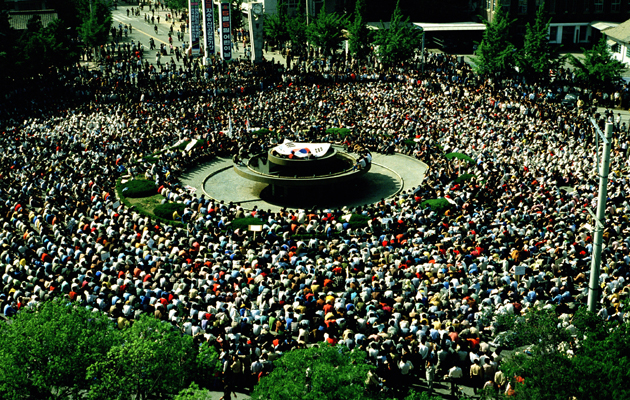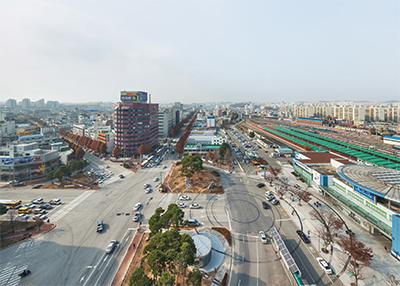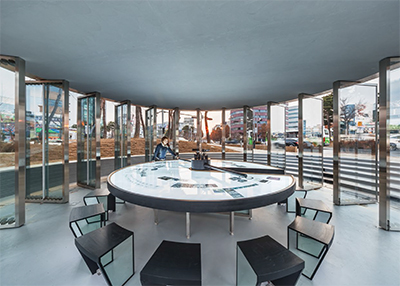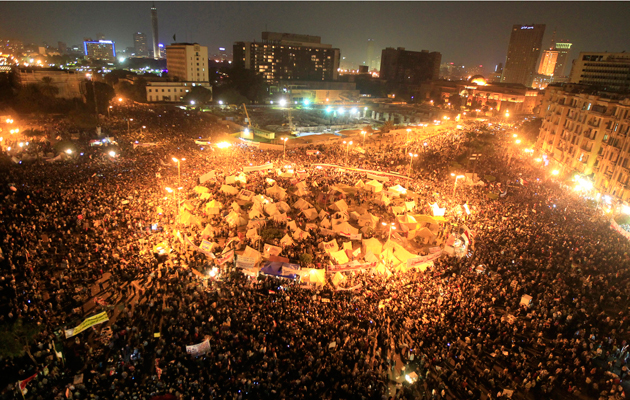|
|
||
|
The history of these banal, utilitarian instruments of traffic management has become entangled with that of political uprising, Eyal Weizman argues in his latest book This project started with a photograph. It was one of the most arresting images depicting the May 1980 Gwangju uprising, recognised now as the first step in the eventual overthrow of the military dictatorship in South Korea. The photograph (above) depicts a large crowd of people occupying a roundabout in the city center. Atop a disused fountain in the middle of the roundabout a few protestors have unfurled a South Korean flag. The roundabout organised the protest in concentric circles, a geometric order that exposed the crowd to itself, helping a political collective in becoming. It had an uncanny resonance with events that had just unfolded: in the previous year a series of popular uprisings spread through Tunisia, Egypt, Bahrain, Oman, Yemen, Libya, and Syria. These events shared with Gwangju not only the historical circumstances – they too were popular protests against military dictatorships – but, remarkably, an urban-architectural setting: many of them similarly erupted on roundabouts in downtown areas. The history of these roundabouts is entangled with the revolutions that rose from them. The photograph of the roundabout—now the symbol of the “liberated republic” – was taken by Na Kyung-taek from the roof of the occupied Provincial Hall, looking toward Geumnam-ro, only a few hours before the fall of the “Gwangju Republic”. In the early morning hours of the following day, the Gwangju uprising was overwhelmed by military force employing tanks and other armed vehicles. The last stand took place at the roundabout. The scene immediately resonates with the well-known photographs of people gathering in Tahrir Square in early 2011. Taken from different high-rise buildings around the square, a distinct feature in these images is the traffic circle visible by the way it organises bodies and objects in space. These images became the symbol of the revolution that led to the overthrow of President Hosni Mubarak in February 2011 – an event described by urban historian Nezar AlSayyad as “Cairo’s roundabout revolution”. But the Gwangju photograph also connects to images of other roundabouts that erupted in dissent in fast succession throughout the Middle East. Before Tahrir, as Jonathan Liu noted in his essay Roundabouts and Revolutions, it was the main roundabout in the capital of Tunisia – subsequently renamed Place du 14 Janvier 2011 after the date on which President Zine el-Abidine Ben Ali was forced to flee the country. Thousands of protesters gathered at the roundabout in Tunis and filled the city’s main boulevard. A main roundabout in Bahrain’s capital Manama erupted in protests shortly after the overthrow of Mubarak in Egypt. Its central traffic island became the site of popular protests against the government and the first decisive act of military repression: the protests were violently broken up and the roundabout itself destroyed and replaced with a traffic intersection. In solidarity with the Tahrir protests, the roundabouts in the small al-Manara Square in Ramallah and the immense Azadi Square in Tehran also filled with protesters. These events, too, were violently suppressed. The roundabouts in Tehran and Ramallah had also been the scenes of previous revolts. In 2009 the Azadi roundabout in Iran’s capital was the site of the main protests of the Green Movement contesting President Mahmoud Ahmadinejad’s reelection. Hamid Dabashi, a literature professor at Columbia University and one of the most outspoken public intellectuals on these revolutions, claims that the Green Movement was inspirational for the subsequent revolutionary wave in the Arab world. In Palestine, revolt was a permanent consequence of life under occupation, and the al-Manara roundabout was a frequent site of clashes between Palestinian youth and the Israeli military. The sequence of roundabout revolutions evolved as acts of imitation, each building on its predecessor, each helping propel the next.
Gwanju Folly II: 2013 design by Weizman and Samaneh Moafi for the “Roundabout Revolution Folly”
Aeriel view: “Our folly is composed of concentric circles – marking the exact orbits of the roundabouts of [revolutions] and a pavilion with a large round table inside”
Interior view of the pavilion, which reflects on “the relation between the roundabout revolution and round table politics, the protests in the streets and the necessary postrevolutionary brinkmanship” Roundabouts were of course not only exhilarating sites of protest and experiments in popular democracy, but moreover they were places where people gathered and risked their life. The Gwangju uprising is, thus, the first of the roundabout revolutions. Liu wrote: “In all these cases, the symbolism is almost jokingly obvious: what better place to stage a revolution, after all, then one built for turning around?” What better way to show solidarity across national borders than to stage protests in analogous places? Why roundabouts? After all, they are banal, utilitarian instruments of traffic management, certainly not prone to induce revolutionary feeling. Other kinds of sites – squares, boulevards, favelas, refugee camps – have served throughout history as the setting for political protest and revolt. Each alignment of a roundabout and a revolution has a specific context and diverse causes, but the curious repetition of this phenomenon might give rise to several speculations. Urban roundabouts are the intersection points of large axes, which also puts them at the start or end of processions. Occupying a roundabout demonstrates the power of tactical acupuncture: it blocks off all routes going in and out. Congestion moves outward like a wave, flowing down avenues and streets through large parts of the city. By pressuring a single pivotal point within a networked infrastructure, an entire city can be put under siege (a contemporary contradistinction to the medieval technique of surrounding the entire perimeter of a city wall). Unlike public squares, which are designed as sites for people to gather (therefore not interrupting the flow of vehicular traffic) and are usually monitored and policed, roundabout islands are designed to keep people away. The continuous flow of traffic around them creates a wall of speeding vehicles that prohibits access. While providing open spaces (in some cities the only available open spaces) these islands are meant to be seen but not used. Another possible explanation is their symbolic power: they often contain monuments that represent the existing regime. The roundabouts of recent revolutions had emblematic names – Place du 7 Novembre 1987, the date the previous regime took power in Tunisia; “Liberty” (Azadi), referring to the 1979 Iranian Revolution; or “Liberation” (Tahrir), referring to the 1952 revolutions in Egypt. Roundabout islands often had statues, both figurative and abstract, representing the symbolic order of regimes. Leaders might have wished to believe that circular movement around their monuments was akin to a form of worship or consent. While roundabouts exercise a centripetal force, pulling protestors into the city center, the police seek to generate movement in the opposite direction, out and away from the center, and to break a collective into controllable individuals that can be handled and dispersed. The most common of all centrifugal forces of urban disorganisation during protests is tear gas, a formless cloud that drifts through space to disperse crowds. From Gwangju to Cairo, Manama to Ramallah, hundreds of tear-gas canisters were used largely exceeding permitted levels in an attempt to evict protesters from public spaces. The bodily sensation of the gas forms part of the affective dimension of the roundabout revolution. When tear gas is inhaled, the pain is abrupt, sharp, and isolating. The eyes shut involuntary, generating a sense of disorientation and disempowerment. Protestors have found ways to mitigate the toxic effects of this weapon. Online advice is shared between activists from Palestine through Cairo to Ferguson. The best protection is offered by proper gas masks. Improvised masks made of mineral water bottles cut in half and equipped with a filter of wet towels also work, according to online manuals. Some activists wear swim goggles and place wet bandanas or kaffiyehs over their mouths. To mitigate some of the adverse effects, these improvised filters can be soaked in water, lemon juice, vinegar, toothpaste, or wrapped around an onion. When nothing else is at hand, breathe the air from inside your shirt and run upwind onto higher ground. When you have a chance, blow your nose, rinse your mouth, cough, and spit. |
Words Eyal Weizman
Above: “Liberated Gwangju”: Protesters gather at the roundabout in front of Provincial Hall in Gwangju, May 26, 1980 (photo by Na Kyung-taek) |
|
|
||
|
Tahrir Square, Cairo, in February 2011 |
||






















